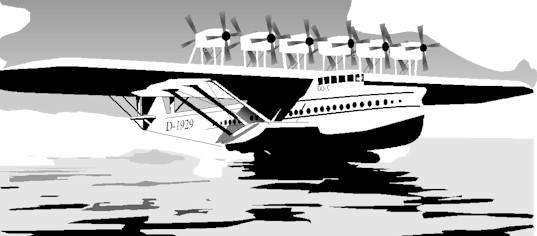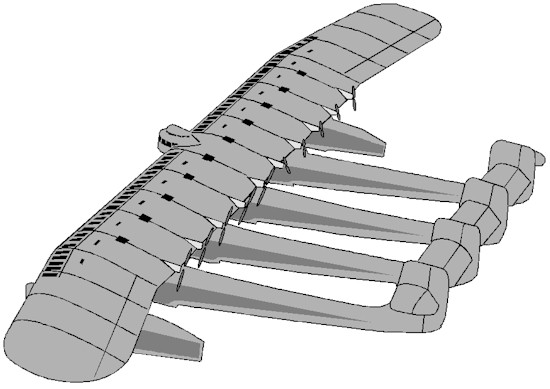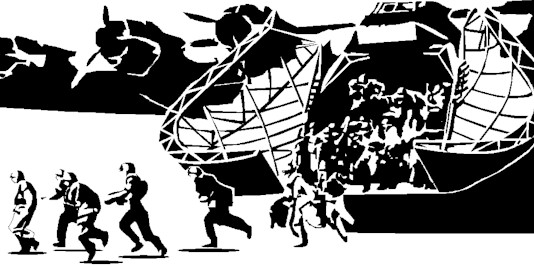|
|||||||||||||||||||||||||||||||||||||||||||||
|
|||||||||||||||||||||||||||||||||||||||||||||
|
|||||||||||||||||||||||||||||||||||||||||||||
| Between
the wars there were many firms who wanted to have larger airplanes, so
they could move more people over a longer range. Larger airplanes need
longer airstrips. Since there were no long airstrips available at that
time, flying boats were introduced. Most of the giants between the wars
were flying boats. Sikorsky, Short and several other firms built their
flying boats. But the most remarkable flying boat of that time was surely
the German Dornier Do X. This giant had 12 engines mounted on top
of the wing. The interior was pure glitter and glamour. But the project
itself was an economical disaster. Even 12 engines were not enough to put
some speed or height into this plane. Even Lufthansa (German airlines) was
not interested to buy a Dornier X.
|
|||||||||||||||||||||||||||||||||||||||||||||
|
|||||||||||||||||||||||||||||||||||||||||||||
|
|||||||||||||||||||||||||||||||||||||||||||||
| The Dornier Do X was an answer to the request of the
Reichsverkehrministerium (RVM). Their "Vorbereiting des
Transozeanischen Luftverkehrs" (preparation for transatlantic air
travel) got several proposals. There were several proposals that couldn't
be achieved in that time. Rumpler made one of these designs. The
design used 10 engines of 1000 hp with pusher props. Span would be 94 m
(308.4 ft). The design had 4 hulls and 2 stabilizers. Tails were connected
to each other. Passengers were seated in the wing. The design of Dornier
was easier to construct than this design. |
|||||||||||||||||||||||||||||||||||||||||||||
|
|||||||||||||||||||||||||||||||||||||||||||||
|
Norman Bel Geddes (1893-1958), an American
industrial designer, came in 1932 with a proposal for another giant. His
Airliner # 4 was designed with assistance of the German engineer, Dr Otto
Koller. Geddes design would be veeeery big. Span 160 m (525 ft), nine
decks, two elevators, place for 451 passengers and a crew of 155. The
hulls contained kitchens, crew quarters, lifeboats and … 2 aircraft's.
These aircrafts could be launched in flight to the rear. If that would not
be enough. There were also luxurious staterooms, a gymnasium, dining room
with dance floor, promenade decks, verandas, bar and many more. To me this
sounds more like a cruise ship than to an airplane. To get the plane in
the air there were 20 engines. Typical for this design … there were also
6 reserve engines, which could be placed in flight. This power would get
the plane to a cruise speed of 160 km/h (99 mph). There is a great site about this giant airplane. http://home.att.net/~dannysoar/BelGeddes.htm
Go check it out. It has some nice drawings of the design. The author of the original article thought that this
design could only be operational when using ground effect. I believe that
his thought is right. Ground effect … to me is the way to create the
giants of tomorrow. Soon there will be a section on that item as well in
this site. |
|||||||||||||||||||||||||||||||||||||||||||||
| At the beginning of WW II the Germans built another giant. It was a glider! The Messerschmidt 321 would be used during the invasion of England. The glider could carry a lightweight tank or many equipped soldiers. The Battle of Britain gave the Allied control over their own air. Using German gliders would be suicide under these conditions. So the plan for using the gliders dropped. But they equipped the glider with engines so they could use them as transport airplanes. First they used 4 engines, quickly they placed 2 more. The name changed to Messerschmidt 323. The nickname was "Gigant". | |||||||||||||||||||||||||||||||||||||||||||||
|
|||||||||||||||||||||||||||||||||||||||||||||
| Control over the air was not the only problem of the Messerschmidt 321. Getting it into the air was another. There were no giant tow planes at that time. And the pilots were a bit skeptic about this plane made of wood, bars and fabric. They had to use 3 airplanes ("Troika-Schlepp") at once to tow the prototype into the air. The pilots of the test flights found out that the airplane was very stable in the air, but that you needed a lot of arm muscles to steer the plane. Soon they added place for a co-pilot. The problem with the tow plane dropped when Heinkel made their He 111 "Zwilling" ("Twin"). This was a combination of two He 111's with a extra engine in the middle. This airplane had the necessary power for the Messerschmidt 321. Still they used rocket assistance to get the fully loaded gliders in the air. | |||||||||||||||||||||||||||||||||||||||||||||
|
|||||||||||||||||||||||||||||||||||||||||||||
| The
Messerschmidt 321 had several new features. It has a landing gear that it
could drop. Well, it was not a landing gear, it was more sort of a
take-off gear. The glider landed on skids. Also new was a loading door at
the front. Using a ramp tanks, trucks, artillery or soldiers could easily
enter the glider. When the glider landed, the tank drove through the front door.
The Messerschmidt 323 gave the possibility to check the center of gravity
while loading. Somehow they could see this at the landing gear (the "Gigant"
had a new landing gear configuration of 10 landing wheels). But the most
remarkable thing were the gunners who were placed in the wing. Like we
said in the sector "Theory, Goal of your design, Larger
airplanes", you can place pilots, gunners or other personnel anywhere
you like in a giant. As you can see, the Messeschmidt 323 is one of my favorites. I really love the simplicity of the design. |
|||||||||||||||||||||||||||||||||||||||||||||
|
|||||||||||||||||||||||||||||||||||||||||||||
|
|||||||||||||||||||||||||||||||||||||||||||||
| During WW II another giant was born on paper. Howard Hughes was a man who loved to create airplanes which reaches the limits. It had to be the fastest, the smallest or ... the largest. And this is the third reason to create a giant. The will to have the greatest (sounds like a typical male problem). Hughes design, named the "Hercules" (but better known under the name "The Spruce Goose"), was a answer to the need for transport in the Pacific. At that time transport by boat was dangerous. Many U-boats were waiting. So Howard Hughes wanted a large airplane to transport all what was needed by air. The design was on paper during the war, but the airplane flew after the war. | |||||||||||||||||||||||||||||||||||||||||||||
| Hughes had many
problems building the prototype. Mostly thanks to himself. He never could make up his
mind. He changed the design several times. We will not bore you to death explaining all
the other problems he had. But we can tell you ... the plane was huge. It flew once. Not that it lacked the power, but Howard Hughes didn't get permission to take off. Hughes wouldn't be Hughes if he didn't show to the public that it could take off. So he got permission to make a taxi-run on water. During this taxi-run, he applied power, set the flaps on take-off and ... took off. Yes, it could fly. After this flight it was stored in a dome near the place where it flew. Recently they moved the whole airplane to Evergreen Aviation Educational Center in Mc Minnville in Oregon. The Hughes HK-1 is still the largest airplane build. |
|||||||||||||||||||||||||||||||||||||||||||||
|
|||||||||||||||||||||||||||||||||||||||||||||
| There is another plane that is quite remarkable in design and size. What happened? Several airline companies dropped their Stratocruisers when turboprop and jet-engines became available in civil air transport. Stratocruisers could be bought at a cheap price. Most were bought by Lee Mansdorf and were stocked in California. Former bomber- and transport pilot John M. "Jack" Conroy lived there. NASA had in that time problems moving segments of the Saturn-rocket for the Apollo space project. Conroy left his job, took a loan and started work on a conversion of a Stratocruiser. He added 5 meter (16.40 ft) to the fuselage and placed a enormous "tube" in top of the lower deck. Total internal stock volume became 826,5 m3 (29 187 cubic ft). The "Guppy" was born. | |||||||||||||||||||||||||||||||||||||||||||||
|
|||||||||||||||||||||||||||||||||||||||||||||
| In 1960 he presented
the concept to NASA-officers. NASA was pleased with the idea and asked for exclusive
user-rights for two models. Airbus Industries was also interested and bought some models
to transport Airbus-components to the final assembly. There were several sorts of Guppy's.
The last version was the 201 with Allison turboprops. I once saw a weird airplane over Aalst, Belgium at rather high altitude. It had a very fat fuselage. It could only have been a Guppy. |
|||||||||||||||||||||||||||||||||||||||||||||
|
|||||||||||||||||||||||||||||||||||||||||||||
| I know that the
largest operational airplane is a design of the Russian firm Antanov. I will describe his
forerunner, the Lockheed C-5 Galaxy. "Huh? Forerunner?" I hear you think. Let's
say that the main difference between the Antanov and the earlier produced (first flight 30
June 1968) Galaxy is the tail. The stabilisator of the Galaxy is placed on top of the
vertical tail. The Antanov has a conventional tail. The difference in size is a few meters
(feet). I don't blame the Russians of making a copy, it is like the Russians said about
their own design of the Space Shuttle "The laws of aerodynamics are the same to
Americans or Russians". The Galaxy was possible thanks to his engines. These new engines made it possible to design this airplane with just 4 engines. Using any other engine would lead to a lot more engines needed. It has the same basic shape as the smaller C-141Starlifter. A high wing with engines mounted in gondolas underneath, a T-tail and a raised back section with loading doors. But it has also a new design of nose. The nose can be raised to clear access to the cargo room. The Galaxy has the unique feature of "Roll in - Roll out". This means that a vehicle can ride onboard and ride off without turning or riding backwards. The airplane has in a upper deck a roomy cockpit in the nose and a extra room for 73 passengers behind the main wing spar. The cargo room is 5,79 m (19 ft) wide and 36,88 m (121 ft) long and has a volume of 985 m2 (34786 cubic ft.). Height varies between 2,9 m (9.5 ft) (under the wing) to 4,11 m (13.5 ft) in the back section. |
|||||||||||||||||||||||||||||||||||||||||||||
|
|||||||||||||||||||||||||||||||||||||||||||||
|
|||||||||||||||||||||||||||||||||||||||||||||
I know that there are many other giants. But this collection has some unique features.
In the sector "Few of my thoughts" you will find one of my own ideas (Sea parasite). It will probably fit in the sector utopia airplanes, but it was pure fun to use my imagination in those proportions. Just try it yourself. |
|||||||||||||||||||||||||||||||||||||||||||||






